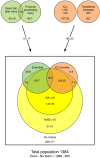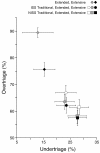Calculating trauma triage precision: effects of different definitions of major trauma
- PMID: 22902009
- PMCID: PMC3464123
- DOI: 10.1186/1752-2897-6-9
Calculating trauma triage precision: effects of different definitions of major trauma
Abstract
Background: Triage is the process of classifying patients according to injury severity and determining the priority for further treatment. Although the term "major trauma" represents the reference against which over- and undertriage rates are calculated, its definition is inconsistent in the current literature. This study aimed to investigate the effects of different definitions of major trauma on the calculation of perceived over- and undertriage rates in a Norwegian trauma cohort.
Methods: We performed a retrospective analysis of patients included in the trauma registry of a primary, referral trauma centre. Two "traditional" definitions were developed based on anatomical injury severity scores (ISS >15 and NISS >15), one "extended" definition was based on outcome (30-day mortality) and mechanism of injury (proximal penetrating injury), one "extensive" definition was based on the "extended" definition and on ICU resource consumption (admitted to the ICU for >2 days and/or transferred intubated out of the hospital in ≤2 days), and an additional four definitions were based on combinations of the first four.
Results: There were no significant differences in the perceived under- and overtriage rates between the two "traditional" definitions (NISS >15 and ISS >15). Adding "extended" and "extensive" to the "traditional" definitions also did not significantly alter perceived under- and overtriage. Defining major trauma only in terms of the mechanism of injury and mortality, with or without ICU resource consumption (the "extended" and "extensive" groups), drastically increased the perceived overtriage rates.
Conclusion: Although the proportion of patients who were defined as having sustained major trauma increased when NISS-based definitions were substituted for ISS-based definitions, the outcomes of the triage precision calculations did not differ significantly between the two scales. Additionally, expanding the purely anatomic definition of major trauma by including proximal penetrating injury, 30-day mortality, ICU LOS greater than 2 days and transferred intubated out of the hospital at ≤2 days did not significantly influence the perceived triage precision. We recommend that triage precision calculations should include anatomical injury scaling according to NISS. To further enhance comparability of trauma triage calculations, researchers should establish a consensus on a uniform definition of major trauma.
Figures


References
-
- Resources for optimal care of the injured patient: 2006. American College of Surgeons, Chicago; 2006. - PubMed
-
- Davenport RA, Tai N, West A, Bouamra O, Aylwin C, Woodford M, McGinley A, Lecky F, Walsh MS, Brohi K. A major trauma centre is a specialty hospital not a hospital of specialties. Br J Surg. 2010;97:109–117. - PubMed
LinkOut - more resources
Full Text Sources

